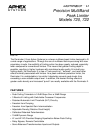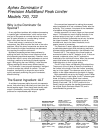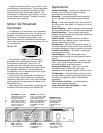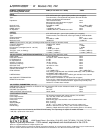
Why is the Dominator So
Special?
A very significant problem with wideband processing
is “spectral gain intermodulation” which occurs when
one part of the spectrum controls the level of another
part. A typical situation is a vocalist being “sucked
down” every time the kick drum hits.
Since most energy is contained in the lower
frequencies, they tend to control the level of the entire
spectrum. When the lower frequencies are above the
limit threshold the higher frequencies are attenuated
thus causing the output to sound dull.
Multiband processing solves these problems by
splitting the audio into two or more frequency bands
and processing each band separately. However, more
bands often result in many more parameters to control
including a method of summing the bands together
again. While giving the user flexibility, it also requires
different settings for almost every different source.
The Dominator ll uses program dependent, intelligent
circuits to reduce the number of controls. The user,
therefore, has flexibility to shape the sound while
quickly and easily achieving the goal of consistent,
effective limiting.
The Secret Ingredient: ALT
A multiband processor splits the audio into separate
bands, limits each band individually and then sums the
bands together again. Even though each band’s peak
output is predictable, summing the bands together
produces an unpredictable peak output.
One conventional approach to making the summed
output predictable is to use a wideband limiter after the
summing. This, however, introduces all the drawbacks
of wideband limiting discussed above.
Another approach is to use a clipper on the summed
output. This causes too much clipping distortion if the
summed output is too high. In order to avoid this
distortion the limiters’ thresholds are set very far below
the clipper threshold. The drawback is a loss of
loudness and, due to the lower thresholds, much
greater amount of processing.
The Dominator ll uses a patented method to produce
a predictable peak output while maintaining maximum
loudness without audible distortion- the Automatic Limit
Threshold (ALT). The outputs of the three bands are
summed and sent to the ALT detector circuit. If the sum
exceeds a reference value, the ALT reduces the
thresholds of the individual limiters. When the summed
output falls below the reference value the limit
thresholds return to their original setting.
The ALT circuit has a self-adjusting finite attack time.
The amount of time it takes to lower the thresholds of
the limiters is the length of time the limiters’ overshoot
may be in the clipper. The reference value of the ALT in
relation to the clipper determines the depth of clipping.
Both parameters are set by the Density control. When
the Density control is set higher, the ALT reference gets
closer to clipping, and the attack time is slower,
producing more clipping. The opposite occurs when
Density is set lower. The “0 RCH” position for the
Density control emulates the standard parameters of
the original Studio Dominator Model 700, and is
recommended for general use.
Aphex Dominator II
Precision MultiBand Peak Limiter
Models 720, 722
INPUT GAIN - adjusts
input level ±15dB.
Center detent is unity
gain.
PROCESS OFF/ON -
switches the audio
through the unit or
through bypass relays.
LF EQ - adjust input
level to the low
frequency band ±5dB.
Center detent is flat
response below limiting.
XOVER 1 - switches
the crossover point
between low and mid
bands from 100Hz to
RELEASE - adjusts
release time of the
limiters between
150mSec (fully
clockwise) and 7Sec
(fully counter-clockwise).
HF EQ - adjusts input
level to the high
frequency band ±5dB.
Center detent is flat
STEREO
forces th
band to
limiting
the othe
band in
has a gr
limiting.
XOVER
crossov
mid and
1.7kHz
Model 720






